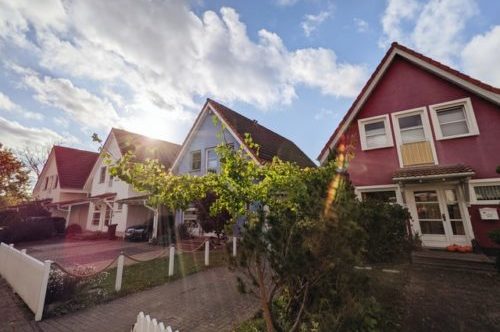
And what does the location of American ad filterers reveal about their political leanings?
The last time we looked at the question of location, one trend emerged: cities. In 2017, the data we examined revealed that 68.8% of ad blockers lived in urban areas. But the world has changed a lot since 2017. And the pandemic ushered in an unprecedented era of remote work, allowing former urbanites to relocate.
And relocate they did.
In 2017, 21% of respondents lived in the suburbs. Now that number has more than doubled and a half of all ad filterers—48.9%—call the suburbs home. One third—exactly 33.3%—live in urban areas. And 17.8% live in the countryside.
So: what does that mean in terms of political affiliation?
Urban vs. rural: the traditional approach
Prior to 2020, the trend was clear: city-dwellers leaned Democrat, and rural folk leaned Republican.
From Pew Research:
Rural areas tend to have a higher concentration of Republicans and Republican-leaning independents, while a majority of Americans in urban communities identify as Democrats or lean toward the Democratic Party. These patterns have become more pronounced over the past two decades as rural areas have moved in a Republican direction and urban counties have become even more Democratic. (Source)
But who lives in the suburbs, according to Pew Research? That’s where things get interesting. According to research done before the pandemic, “Americans who live in the suburbs are about evenly divided in their partisan loyalties.”
The Great Covid Relocation
As we know, COVID-19 changed everything. And that includes demographics. People left dense urban areas in large numbers, choosing sparsely-populated suburbs, large backyards, walkable neighborhoods and nearby parks as urban amenities shuttered for months, if not years, at a time.
The exodus was particularly pronounced from New York and San Francisco, according to The New York Times. Approximately 30 million households changed address.
But what’s interesting is that the same places that attracted people in 2020, at the height of pandemic relocation, were the same places that attracted people in 2019, before the world had heard of COVID-19 and a most people thought of a pandemic as the plot from a Steven Soderbergh movie.
And the places people located to contain large swaths of suburban areas.
These smaller metros—Boise, Idaho; Sarasota, Florida; Youngstown, Ohio—were attractive to people looking for a new home even prior to the era of Zoom and mask mandates. And they’ve remained appealing options for people being priced out of other, larger metropolitan areas, professionals looking to make a change, and employees whose families are growing and whose need for local playgrounds are more pressing than the need to be in the center of it all.
This suggests that, despite reports that a great COVID-related flight would turn American demographics on its head, things have remained the same.
And this aligns with what we know about the way that ad filterers vote: the majority vote Democrat, the smallest percentage vote Republican, but more than a quarter are undecided or elect not to say—in other words, the political profile of a suburban American voter.
AAX is devoted to knowing everything there is to know about ad filterers. In one previous study we looked into what makes this demographic unique, another study examined their purchasing habits, and our most recent study dug deep into ad filterer motivation: the reasons ad filterers avoid advertisements, and how and why those reasons change.
Our passion for all things ad filterer is why we’ve turned our attention to an issue that’s capturing everyone’s attention: ad filterers’ political profiles. We’ve looked through the fascinating findings over at the GlobalWebIndex (GWI) to compile a new study—American Ad Blocking Users’ Political Profile—available for free download in May 2022.
- Data, Studies, Insights